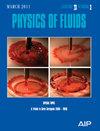Numerical simulation of manta ray swimming using a smoothed-particle hydrodynamics method and investigation of the vortical structures in the wake
IF 4.1
2区 工程技术
Q1 MECHANICS
引用次数: 0
Abstract
A three-dimensional smoothed-particle hydrodynamics (SPH) method is used to study the moving boundary problem of a swimming manta ray, focusing on Eulerian and Lagrangian coherent structures. The manta ray's boundary motion is predefined by a specific equation. The calculated hydrodynamic results and Eulerian coherent structures are compared with data from the literature. To improve computational stability and efficiency, the δ+-SPH model used in this study incorporates tensile instability control and an improved adaptive particle-refinement technique. By comparing and analyzing the Eulerian and Lagrangian coherent structures, the relationship between these vortex structures and hydrodynamic force generation is examined, revealing the jet mechanism in the manta ray's wake. The SPH method presented herein is robust and efficient for calculating biomimetic propulsion problems involving moving boundaries with large deformations, and it can accurately identify vortex structures. The approach of this study provides an effective simulation tool for investigating biomimetic propulsion problems such as bird flight and fish swimming.使用平滑粒子流体力学方法对蝠鲼游动进行数值模拟,并研究尾流中的涡流结构
采用三维平滑粒子流体力学(SPH)方法研究了游动鳐鱼的移动边界问题,重点研究了欧拉和拉格朗日相干结构。鳐鱼的边界运动由特定方程预设。计算得出的流体力学结果和欧拉相干结构与文献数据进行了比较。为了提高计算的稳定性和效率,本研究中使用的 δ+-SPH 模型采用了拉伸不稳定性控制和改进的自适应粒子重整技术。通过比较和分析欧拉和拉格朗日相干结构,研究了这些涡旋结构与流体动力产生之间的关系,揭示了蝠鲼尾流中的喷射机制。本文提出的 SPH 方法对于计算涉及大变形运动边界的仿生物推进问题既稳健又高效,而且能准确识别涡旋结构。本研究的方法为研究鸟类飞行和鱼类游泳等仿生物推进问题提供了有效的模拟工具。
本文章由计算机程序翻译,如有差异,请以英文原文为准。
求助全文
约1分钟内获得全文
求助全文
来源期刊

Physics of Fluids
物理-力学
CiteScore
6.50
自引率
41.30%
发文量
2063
审稿时长
2.6 months
期刊介绍:
Physics of Fluids (PoF) is a preeminent journal devoted to publishing original theoretical, computational, and experimental contributions to the understanding of the dynamics of gases, liquids, and complex or multiphase fluids. Topics published in PoF are diverse and reflect the most important subjects in fluid dynamics, including, but not limited to:
-Acoustics
-Aerospace and aeronautical flow
-Astrophysical flow
-Biofluid mechanics
-Cavitation and cavitating flows
-Combustion flows
-Complex fluids
-Compressible flow
-Computational fluid dynamics
-Contact lines
-Continuum mechanics
-Convection
-Cryogenic flow
-Droplets
-Electrical and magnetic effects in fluid flow
-Foam, bubble, and film mechanics
-Flow control
-Flow instability and transition
-Flow orientation and anisotropy
-Flows with other transport phenomena
-Flows with complex boundary conditions
-Flow visualization
-Fluid mechanics
-Fluid physical properties
-Fluid–structure interactions
-Free surface flows
-Geophysical flow
-Interfacial flow
-Knudsen flow
-Laminar flow
-Liquid crystals
-Mathematics of fluids
-Micro- and nanofluid mechanics
-Mixing
-Molecular theory
-Nanofluidics
-Particulate, multiphase, and granular flow
-Processing flows
-Relativistic fluid mechanics
-Rotating flows
-Shock wave phenomena
-Soft matter
-Stratified flows
-Supercritical fluids
-Superfluidity
-Thermodynamics of flow systems
-Transonic flow
-Turbulent flow
-Viscous and non-Newtonian flow
-Viscoelasticity
-Vortex dynamics
-Waves
 求助内容:
求助内容: 应助结果提醒方式:
应助结果提醒方式:


